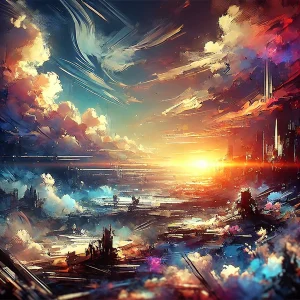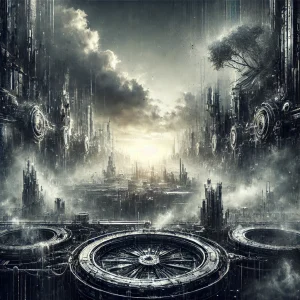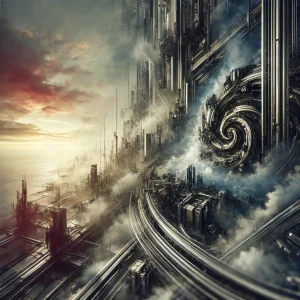Introduction to 'The Price of Smiles': Setting the Stage

Have you ever wondered what the true cost of happiness might be? "The Price of Smiles" (Egao no Daika) is an anime that doesn't shy away from answering this question. Set in the distant world of Soleia, the story revolves around two young women, Yūki Soleil and Stella Shining, who find themselves on opposite sides of a brutal war. Yet, despite their differences, both characters are driven by a common desire: to protect what they hold dear.
Soleia is a land rich in both beauty and sorrow, where smiles can be as powerful as weapons. The anime skillfully blends mecha action with deep emotional storytelling, creating a narrative that’s as engaging as it is heart-wrenching. Yūki, the cheerful princess of the Kingdom of Soleil, leads her people with a radiant smile, believing that joy and optimism can guide them through any challenge. On the other hand, Stella, a stoic and battle-hardened soldier from the Grandiga Empire, views the world through a lens of duty and sacrifice, where emotions are a luxury she can’t afford.
What makes "The Price of Smiles" stand out is its ability to weave these contrasting perspectives into a cohesive story. The world of Soleia is more than just a backdrop; it’s a living, breathing entity that reflects the inner turmoil of its inhabitants. The vibrant landscapes and the advanced technology of the mecha suits aren’t just for show—they symbolize the delicate balance between hope and despair that defines the series.
As the story unfolds, we see how the characters’ smiles—often seen as a symbol of innocence and peace—take on a darker, more complex meaning. In a world where war is inevitable, what does it mean to smile? Is it a sign of strength or a mask to hide the pain? These questions lie at the heart of the anime, making "The Price of Smiles" a thought-provoking journey through the human condition.
Character Profiles: The Faces Behind the Smiles

Let's talk about the heart of "The Price of Smiles"—the characters who breathe life into this emotional tale. At the forefront of this story are two young women, Yūki Soleil and Stella Shining, whose journeys are as compelling as they are tragic.
First, we have Yūki Soleil, the princess of the Kingdom of Soleil. Now, imagine being a leader at just twelve years old. That’s Yūki. She’s not just a ruler; she’s the embodiment of hope and optimism in a world teetering on the brink of war. Yūki’s smile is her greatest weapon, a beacon of light for her people. But as the series progresses, we see that her cheerful demeanor is more complex than it seems. It’s not just about being happy; it’s about masking the weight of her responsibilities and the harsh realities she faces as a leader. Her character development is a poignant reflection of innocence meeting the harsh truths of life. Every decision Yūki makes, whether it's leading her army or choosing to trust others, pushes the plot forward, often leading to unforeseen consequences.
On the other side of the battlefield is Stella Shining, a soldier from the Grandiga Empire. Stella is as tough as they come, hardened by the rigors of war. She’s the polar opposite of Yūki—where Yūki leads with her heart, Stella operates with cold, calculated precision. Stella’s smile, when it appears, is more of a rarity, a fleeting moment in a life defined by discipline and duty. But beneath her stoic exterior lies a deep well of emotions, struggles, and questions about the very war she’s fighting. As the series unfolds, Stella’s journey becomes one of introspection. She begins to question the motives of her leaders, the purpose of the war, and even her own actions. Her character growth is a gradual peeling away of layers, revealing the vulnerabilities and doubts that even the most battle-hardened soldiers carry.
What makes Yūki and Stella so intriguing is how their choices ripple through the narrative. Yūki’s idealism and Stella’s pragmatism are two sides of the same coin, driving the story forward in unexpected ways. Their interactions, though limited, are charged with the tension of opposing worldviews. It’s fascinating to see how their paths, though so different, are bound by the same underlying desire to protect what they cherish most.
Themes and Symbolism

When it comes to "The Price of Smiles," the themes and symbolism woven into the story are as intricate as they are poignant. At its core, the anime delves deep into the true cost of happiness, and how that cost is often far higher than we’d like to admit.
One of the central themes is the cost of peace. In the world of Soleia, peace isn’t just a given—it’s something that comes at a steep price. Yūki Soleil, the princess of the Kingdom of Soleil, embodies this struggle. Her unwavering belief in the power of smiles and joy is tested time and again as she faces the harsh realities of leadership. Yūki’s journey highlights the painful truth that maintaining peace often requires sacrifices that are anything but joyful. It’s a reminder that the pursuit of happiness, especially in a world at war, can lead to devastating consequences.
Another powerful theme is the burden of leadership. Both Yūki and Stella Shining, the stoic soldier from the Grandiga Empire, find themselves carrying the weight of their respective worlds on their shoulders. For Yūki, leadership means making impossible choices—decisions that could mean life or death for her people. For Stella, it’s about loyalty and duty, even when it means putting aside her own emotions. Their paths, though different, converge on the realization that being a leader often means putting others before yourself, even when it breaks your heart.
Moral dilemmas are also at the forefront of this narrative. The characters are constantly faced with choices that blur the lines between right and wrong. In a world where every smile could be a mask for pain, the anime forces its characters—and viewers—to question the true meaning of happiness. Is it worth pursuing at all costs, or does the pursuit itself lead to inevitable sorrow?
Visually, "The Price of Smiles" uses a stark contrast between the bright, hopeful colors of Yūki’s world and the darker, more subdued tones of Stella’s. This contrast isn’t just about aesthetics—it’s a reflection of the internal struggles each character faces. The vibrant landscapes of Soleil represent the fragile hope that Yūki clings to, while the cold, metallic hues of Grandiga mirror Stella’s harsh reality. The symbolism in these visuals reinforces the narrative themes, making the anime not just a story, but an experience that resonates on multiple levels.
Visuals and Animation: Crafting a War-Torn World

Let’s take a moment to appreciate the visual masterpiece that is "The Price of Smiles." From the very first episode, it’s clear that the animation style plays a crucial role in bringing the world of Soleia to life. The series uses a blend of vibrant colors and detailed mecha designs to create a striking contrast between the beauty of the landscape and the harshness of war. This contrast isn’t just for show—it’s a deliberate choice that amplifies the emotional weight of the story.
The animation style is characterized by its sharp, clean lines and dynamic movement, especially in the mecha battles. The mechas themselves, known as “Chrars,” are designed with a level of detail that makes them both imposing and intricate. Each one is a reflection of its pilot, almost as if the machines are an extension of the characters’ own emotions and struggles. When Yūki’s Chrars takes to the battlefield, it’s not just a machine—it’s a symbol of her hope and determination. On the other hand, Stella’s mecha embodies her strength and resolve, with every movement echoing the weight of her responsibilities.
What’s truly impressive is how the visuals go beyond mere aesthetics to enhance the emotional impact of the story. The bright, almost dreamlike colors of Yūki’s kingdom create a stark juxtaposition with the darker, more muted tones of the Grandiga Empire. This visual distinction mirrors the inner worlds of the characters—Yūki’s hopeful outlook versus Stella’s hardened reality. As the series progresses, these colors begin to bleed into each other, symbolizing how their worlds are colliding and how their perspectives are changing.
Even the landscapes in "The Price of Smiles" aren’t just backdrops—they’re integral to the storytelling. The vast, open fields of Soleil, with their rolling hills and endless skies, evoke a sense of freedom and peace, but also a looming vulnerability. In contrast, the cold, industrial environments of Grandiga highlight the oppressive nature of war. The attention to detail in these settings helps to ground the fantastical elements of the story, making the emotional stakes feel real and immediate.
Reception and Impact

When "The Price of Smiles" hit the screens, it sparked a range of reactions across the anime community. Some viewers were immediately drawn to its unique blend of emotional storytelling and mecha action, while others were intrigued by its exploration of deep, thought-provoking themes. Critics and fans alike have found plenty to discuss, from the series' visual style to the complex moral dilemmas faced by its characters.
On the critical side, reviews often praise "The Price of Smiles" for its ambitious narrative. The show’s willingness to tackle heavy subjects like the cost of war and the burdens of leadership sets it apart from more traditional mecha series. Many reviewers have highlighted the emotional depth of the story, noting how it manages to balance intense action scenes with quieter, more introspective moments. The character development, particularly of Yūki Soleil and Stella Shining, has been a focal point of discussion, with many praising how their arcs are interwoven with the overarching themes of the series.
Fans, on the other hand, have had mixed reactions. While many appreciate the show’s deeper messages, some viewers found the pacing to be a bit uneven. The first few episodes, which establish the world and characters, were generally well-received, but the latter half of the series sparked debate. Some fans loved the dramatic twists and the way the story challenges viewers to think about the true cost of peace. Others, however, felt that the emotional weight of the story could have been better balanced with the action elements.
Despite these differing opinions, there's no denying that "The Price of Smiles" has left a lasting impact on the anime community. It’s a series that invites discussion and reflection, encouraging viewers to look beyond the surface and consider the deeper implications of the story. In the broader context of the anime genre, "The Price of Smiles" stands as a bold attempt to blend the mecha genre with more philosophical and emotional storytelling. It may not have achieved blockbuster status, but it has carved out a niche for itself as a series that isn’t afraid to ask difficult questions.
In terms of its place in the anime genre, "The Price of Smiles" is often seen as a series that pushes the boundaries of what a mecha anime can be. By focusing more on the emotional and psychological aspects of its characters, it offers a fresh perspective on the genre. For those who appreciate anime that challenge the status quo, "The Price of Smiles" is a series worth watching and discussing.
